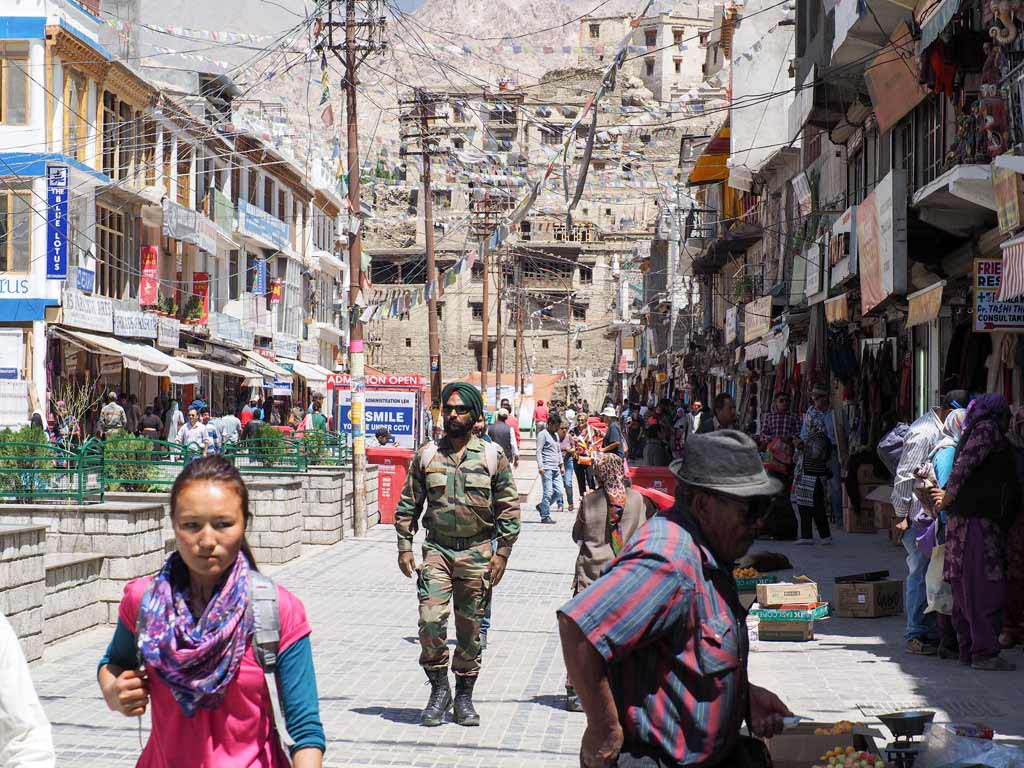Leh, Ladakh
 Ladakh's only real town is Leh, at an altitude of 3500 metres. Leh is an old trading town on the Silk Road that linked India with the Chang Tang and Tibet to the east and Kashmir, the passes of the Karakoram mountains and central Asia to the north and west.
Ladakh's only real town is Leh, at an altitude of 3500 metres. Leh is an old trading town on the Silk Road that linked India with the Chang Tang and Tibet to the east and Kashmir, the passes of the Karakoram mountains and central Asia to the north and west.
North of Leh is the Nubra valley where dromedaries, the two humped camels that caravanned the Silk Roads to the far north and Mongolia, can still be found. The photo below, taken in 2010, is for sale in our Photo Collection.

Before the Chinese annexation of Tibet in 1949, caravans came down from the north loaded with wool and salt to be traded for cottons, silks and spices coming up from India. The old town of Leh was the market place for this trade.

Nowadays, lorries bring consumer goods from India and fruit and veg from Kashmir. Some unofficial trade takes place over the disputed border with China/Tibet to the east. A few years ago we bought some exquisite silver Buddha statues that had come from Lhasa, the capital of Tibet. We bought them from a trader who'd met his father at the border on an unofficial "open border" day. This year tensions between India and China have escalated and there are no such days.
Monks on Market Street, Leh. Judging by their robes these monks with their prayers and bowls have probably come from Nepal.

An aerial view of Leh old town as seen from the Royal Palace. The palace is modelled on Lhasa's Potala Palace, the rooms are now empty except for photographic exhibitions of old Leh and the Silk Road, but it commands a wonderful hilltop presence over the town and affords spectacular views.

Below the Palace is the excellent arts centre called LAMO. Set in a fine old house that's been refurbished in traditional style, it has exhibitions that give you a wonderful insight into old Ladakh.
High above the Palace is the 16th century Tsemo Fort, seen through Buddhist prayer flags above the Royal Palace, Leh.

Wandering round the old backstreets below the Palace you'll come across the old wood fired Muslim bakeries baking their morning bread.

A newly opened Central Asian Museum is located in the Muslim quarter just behind the bakeries. It contains fascinating documents registering the trade and caravans that came to Leh and places Ladakh firmly on the old Silk Roads.
This antique Copper Pitcher in the museum is similar to the Repousse Ewer for sale in our collection.


Leh Palace dominates the skyline to the north, to the south are the snow capped 6000metres mountains of the Stok range.


Leh is still a vigorous bazaar town, aside from the tourist souvenirs there are unusual things to buy. Yak tails anyone? Market Street, Leh.




One of my favourite shops in Leh. They sell a few old nails, coloured rope slippers from the Kulu valley and these hanks of cotton used for butter lamps in the monastery.


Read more about Buddhist monasteries and trekking in Ladakh and Zanskar.
